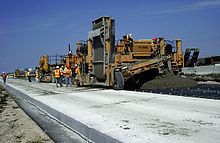Talk:Energetically modified cement/Draft - Snow, April 2014
Mechanical activation of cement and cementitious materials is a process by which a pozzolanic component of a cement is ground in specific varieties of mills in order to increase its reactivity, allowing a larger portion of the pozzolan in the composition of the final cement without compromising its strength.
Mechanical activation makes use of mill variations, such as vibrating, planetary, and counter-rotating mills, which are capable of scoring the surfaces of the fine particles composing the pozzolan, the most common variety of which is fly ash, a common waste product resulting from the burning of coal which is regularly used as a binding agent in the manufacture of Portland cement; as the resulting change of the surface properties of the fly ash or other pozzolan allows it to be used in a larger proportion to the other constituents of the cement without a loss of material strength, and as fly ash is a relatively inexpensive and abundant additive, the overall cost of the resulting cement or concrete can be significantly reduced.
Mechanism of action[edit]
Although fly ash is the most common material to which mechanical activation is applied, other pozzolans, including fine sand, silica fume, volcanic ash, and pozzolana, as well as other complete cement products, such as portland or slag cements, may sometimes be used. Regardless of the material ground in the mill, the ultimate goal of the process is to create high-speed impacts between particles such that they develop a more cracked, pitted and porous surface, increasing the pozzolanic activity of the resulting material. In the case of fly ash, which is commonly formed largely of smooth spherical grains of silicon dioxide and calcium oxide, mechanical activation can substantially increase the reactivity of the processed particulate mass.
Benefits and limitations[edit]
Owing to the relative cheapness of fly ash and certain other pozzolans, mechanical activation can significantly reduce the cost of the final cement or cementitious material to which it is added. However, mechanically activated materials cannot fully replace conventional Portland cement in concrete unless Portland cement itself is the raw material undergoing activation. While mechanical activation allows up to 70% of the composition of a cement to be fly ash, in practice such a large proportion can substantially increase the amount of time necessary for the cement to set to final ideal strength and as such most cements utilizing mechanically activated fly ash do so in amount not exceeding 60%. Depending on the pozzolan used, cements utilizing higher amounts of these additives may also exhibit higher resistance to mechanical and chemical erosion of various types.
Trade variants and usage[edit]
Although the process of increasing pozzolanic activity via high-impact milling is in general known as "mechanical activation", a subset of more specific procedures and their resulting materials has been developed under the trade term of "energetically modified cement" ("EMC"), coined in 1992 by Dr. Vladimir Ronin of Luleå University of Technology

In the United States, mechanically activated cements have been approved for usage by a number of State wide Department of Transport agencies, including PennDOT, TxDOT and CalTrans[1][2], which have collectively developed hundreds of miles of highway paving and bridges using concretes made from cements utilizing mechanically activated fly ash.[1] These projects include the paving of sections of Interstate 10, which is the main U.S. Interstate highway linking Miami, Florida with Los Angeles, California.[1] In these projects, mechanically activated cement complimented traditional Portland cement in proportions of at least 50%.[3] Another notable project is the extension of the passenger terminals at the Port of Houston, Texas where the high-resistances of the pozzolan-heavy cements to chloride– and sulphate–ion permeability are hoped to combat erosion due to seawater.[1]
References[edit]
- ^ a b c d Ronin, V; Elfgren, L (2010). An Industrially Proven Solution for Sustainable Pavements of High-Volume Pozzolan Concrete – Using Energetically Modified Cement, EMC (PDF). Washington DC, United States: Transportation Research Board of the National Academies.
- ^ United States Federal Highway Administration (FHWA). "EMC Cement Presentation January 18, 2011". Washington, DC.
- ^ EMC Cement BV. Summary of CemPozz® (Fly Ash) Performance in Concrete (PDF). EMC Cement BV, 2012.
